BUSNINESS LAW ASSIGNMENT: Provincial Court & Tribunal Visit Report
VerifiedAdded on 2022/08/24
|8
|2135
|22
Report
AI Summary
This report presents a detailed analysis of observations made at the Ontario Court of Justice and the Human Rights Tribunal of Ontario. The first section focuses on a case of dangerous driving observed at the Ontario Court of Justice, detailing the courtroom setting, the roles of the judge, clerk, prosecutor, defense attorneys, and corrective service officers, as well as the specifics of the case, including the defendant's plea and sentencing. The second section shifts to the Human Rights Tribunal, examining a case of unfair dismissal, outlining the tribunal's structure, the roles of the chairman and adjudicators, and the specifics of the dispute involving an employee's back pain and subsequent termination. The final section provides a comparison and contrast of the court and tribunal proceedings, highlighting the differences in procedures, the roles of different parties, and the methods of dispute resolution, emphasizing the distinct functions of each institution within the Canadian legal system. The report concludes with a reference section citing relevant legal and academic sources.
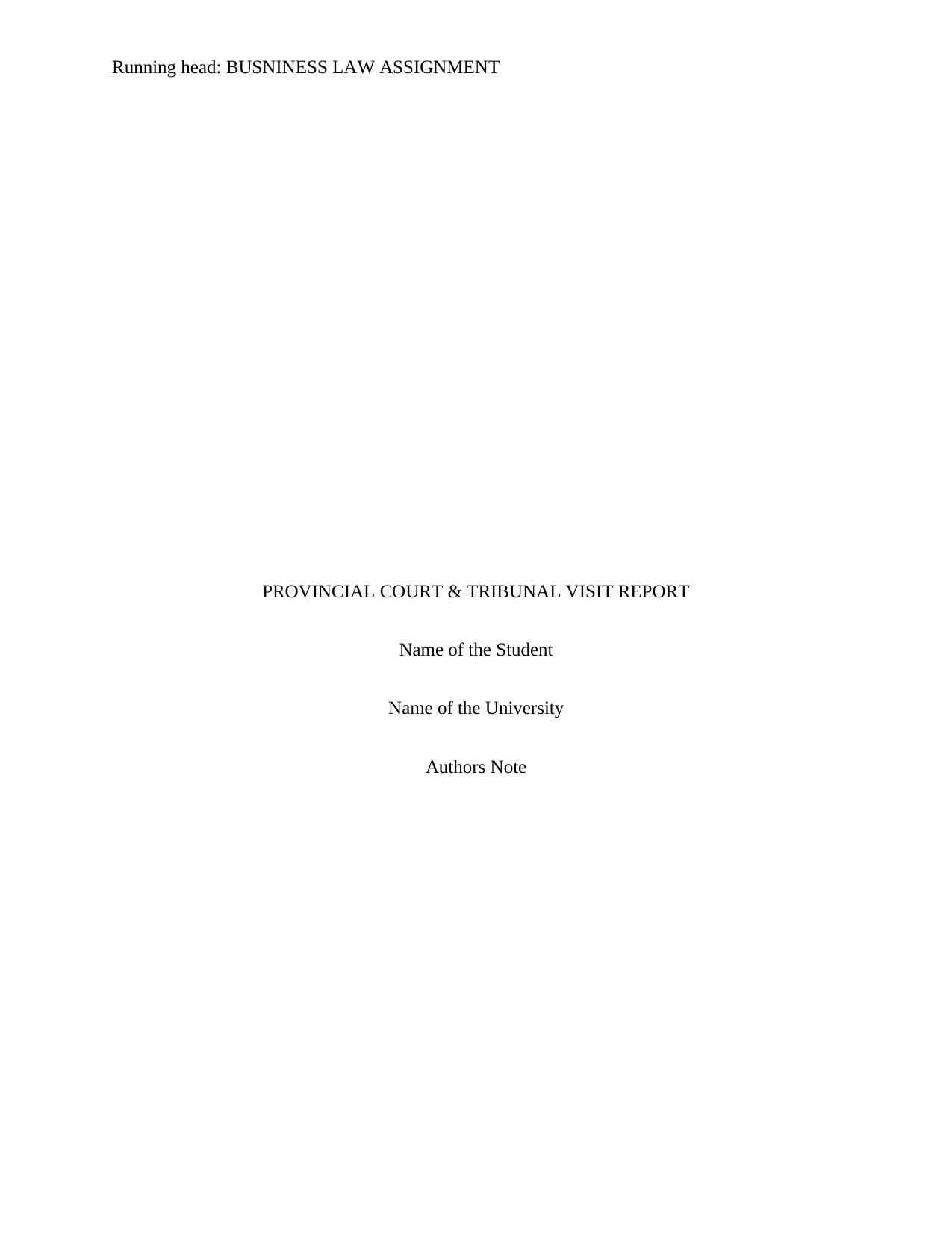
Running head: BUSNINESS LAW ASSIGNMENT
PROVINCIAL COURT & TRIBUNAL VISIT REPORT
Name of the Student
Name of the University
Authors Note
PROVINCIAL COURT & TRIBUNAL VISIT REPORT
Name of the Student
Name of the University
Authors Note
Paraphrase This Document
Need a fresh take? Get an instant paraphrase of this document with our AI Paraphraser
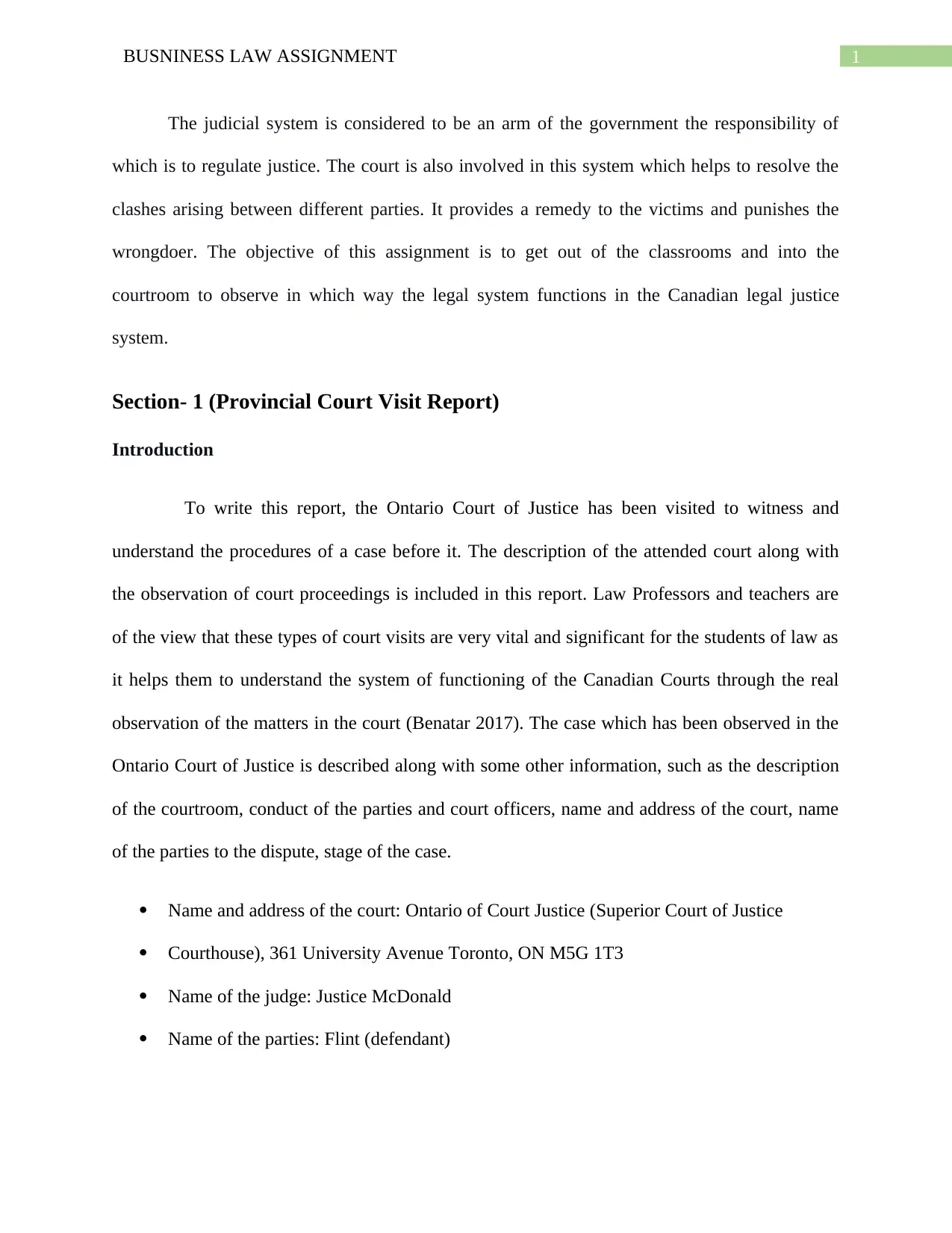
1BUSNINESS LAW ASSIGNMENT
The judicial system is considered to be an arm of the government the responsibility of
which is to regulate justice. The court is also involved in this system which helps to resolve the
clashes arising between different parties. It provides a remedy to the victims and punishes the
wrongdoer. The objective of this assignment is to get out of the classrooms and into the
courtroom to observe in which way the legal system functions in the Canadian legal justice
system.
Section- 1 (Provincial Court Visit Report)
Introduction
To write this report, the Ontario Court of Justice has been visited to witness and
understand the procedures of a case before it. The description of the attended court along with
the observation of court proceedings is included in this report. Law Professors and teachers are
of the view that these types of court visits are very vital and significant for the students of law as
it helps them to understand the system of functioning of the Canadian Courts through the real
observation of the matters in the court (Benatar 2017). The case which has been observed in the
Ontario Court of Justice is described along with some other information, such as the description
of the courtroom, conduct of the parties and court officers, name and address of the court, name
of the parties to the dispute, stage of the case.
Name and address of the court: Ontario of Court Justice (Superior Court of Justice
Courthouse), 361 University Avenue Toronto, ON M5G 1T3
Name of the judge: Justice McDonald
Name of the parties: Flint (defendant)
The judicial system is considered to be an arm of the government the responsibility of
which is to regulate justice. The court is also involved in this system which helps to resolve the
clashes arising between different parties. It provides a remedy to the victims and punishes the
wrongdoer. The objective of this assignment is to get out of the classrooms and into the
courtroom to observe in which way the legal system functions in the Canadian legal justice
system.
Section- 1 (Provincial Court Visit Report)
Introduction
To write this report, the Ontario Court of Justice has been visited to witness and
understand the procedures of a case before it. The description of the attended court along with
the observation of court proceedings is included in this report. Law Professors and teachers are
of the view that these types of court visits are very vital and significant for the students of law as
it helps them to understand the system of functioning of the Canadian Courts through the real
observation of the matters in the court (Benatar 2017). The case which has been observed in the
Ontario Court of Justice is described along with some other information, such as the description
of the courtroom, conduct of the parties and court officers, name and address of the court, name
of the parties to the dispute, stage of the case.
Name and address of the court: Ontario of Court Justice (Superior Court of Justice
Courthouse), 361 University Avenue Toronto, ON M5G 1T3
Name of the judge: Justice McDonald
Name of the parties: Flint (defendant)
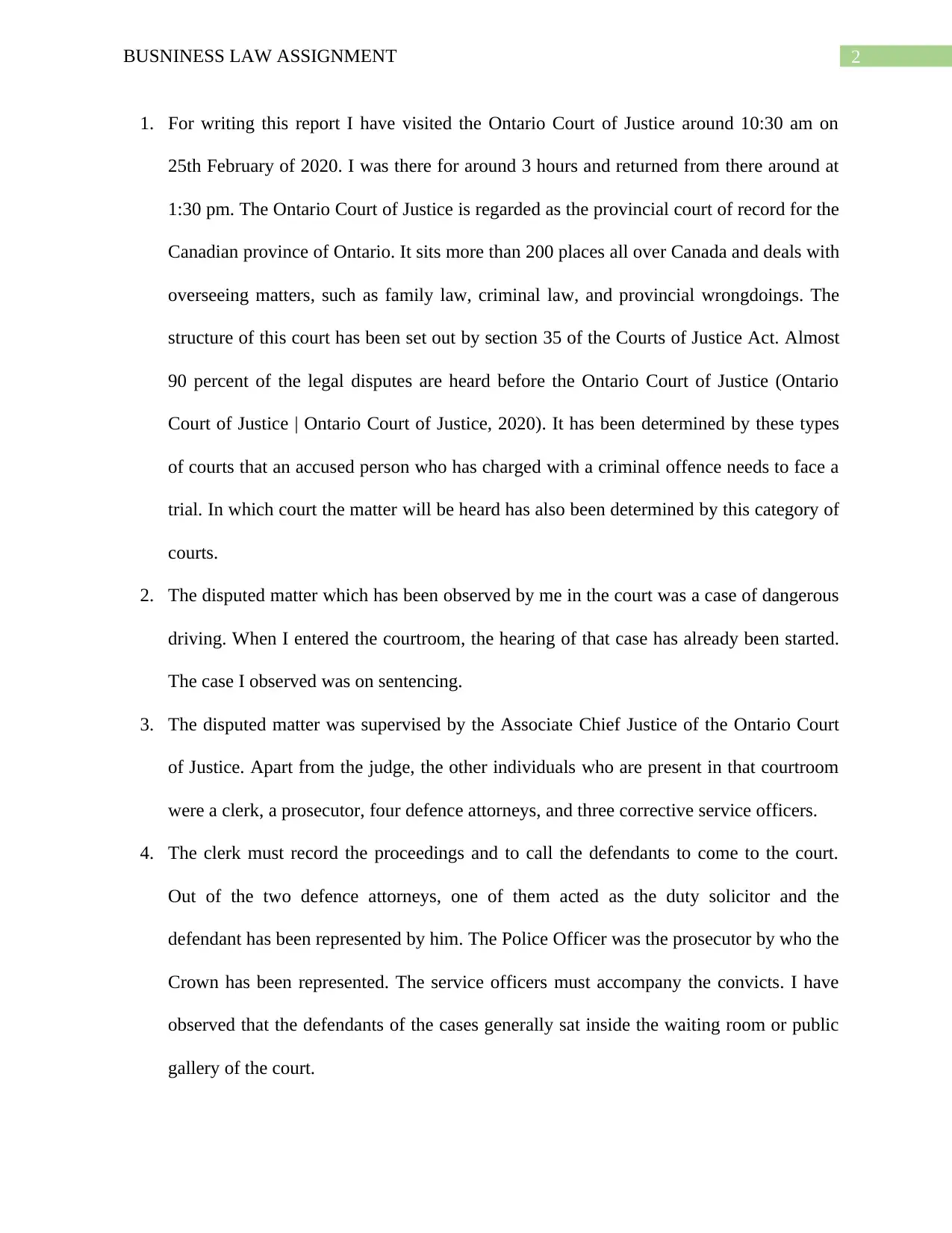
2BUSNINESS LAW ASSIGNMENT
1. For writing this report I have visited the Ontario Court of Justice around 10:30 am on
25th February of 2020. I was there for around 3 hours and returned from there around at
1:30 pm. The Ontario Court of Justice is regarded as the provincial court of record for the
Canadian province of Ontario. It sits more than 200 places all over Canada and deals with
overseeing matters, such as family law, criminal law, and provincial wrongdoings. The
structure of this court has been set out by section 35 of the Courts of Justice Act. Almost
90 percent of the legal disputes are heard before the Ontario Court of Justice (Ontario
Court of Justice | Ontario Court of Justice, 2020). It has been determined by these types
of courts that an accused person who has charged with a criminal offence needs to face a
trial. In which court the matter will be heard has also been determined by this category of
courts.
2. The disputed matter which has been observed by me in the court was a case of dangerous
driving. When I entered the courtroom, the hearing of that case has already been started.
The case I observed was on sentencing.
3. The disputed matter was supervised by the Associate Chief Justice of the Ontario Court
of Justice. Apart from the judge, the other individuals who are present in that courtroom
were a clerk, a prosecutor, four defence attorneys, and three corrective service officers.
4. The clerk must record the proceedings and to call the defendants to come to the court.
Out of the two defence attorneys, one of them acted as the duty solicitor and the
defendant has been represented by him. The Police Officer was the prosecutor by who the
Crown has been represented. The service officers must accompany the convicts. I have
observed that the defendants of the cases generally sat inside the waiting room or public
gallery of the court.
1. For writing this report I have visited the Ontario Court of Justice around 10:30 am on
25th February of 2020. I was there for around 3 hours and returned from there around at
1:30 pm. The Ontario Court of Justice is regarded as the provincial court of record for the
Canadian province of Ontario. It sits more than 200 places all over Canada and deals with
overseeing matters, such as family law, criminal law, and provincial wrongdoings. The
structure of this court has been set out by section 35 of the Courts of Justice Act. Almost
90 percent of the legal disputes are heard before the Ontario Court of Justice (Ontario
Court of Justice | Ontario Court of Justice, 2020). It has been determined by these types
of courts that an accused person who has charged with a criminal offence needs to face a
trial. In which court the matter will be heard has also been determined by this category of
courts.
2. The disputed matter which has been observed by me in the court was a case of dangerous
driving. When I entered the courtroom, the hearing of that case has already been started.
The case I observed was on sentencing.
3. The disputed matter was supervised by the Associate Chief Justice of the Ontario Court
of Justice. Apart from the judge, the other individuals who are present in that courtroom
were a clerk, a prosecutor, four defence attorneys, and three corrective service officers.
4. The clerk must record the proceedings and to call the defendants to come to the court.
Out of the two defence attorneys, one of them acted as the duty solicitor and the
defendant has been represented by him. The Police Officer was the prosecutor by who the
Crown has been represented. The service officers must accompany the convicts. I have
observed that the defendants of the cases generally sat inside the waiting room or public
gallery of the court.
⊘ This is a preview!⊘
Do you want full access?
Subscribe today to unlock all pages.

Trusted by 1+ million students worldwide
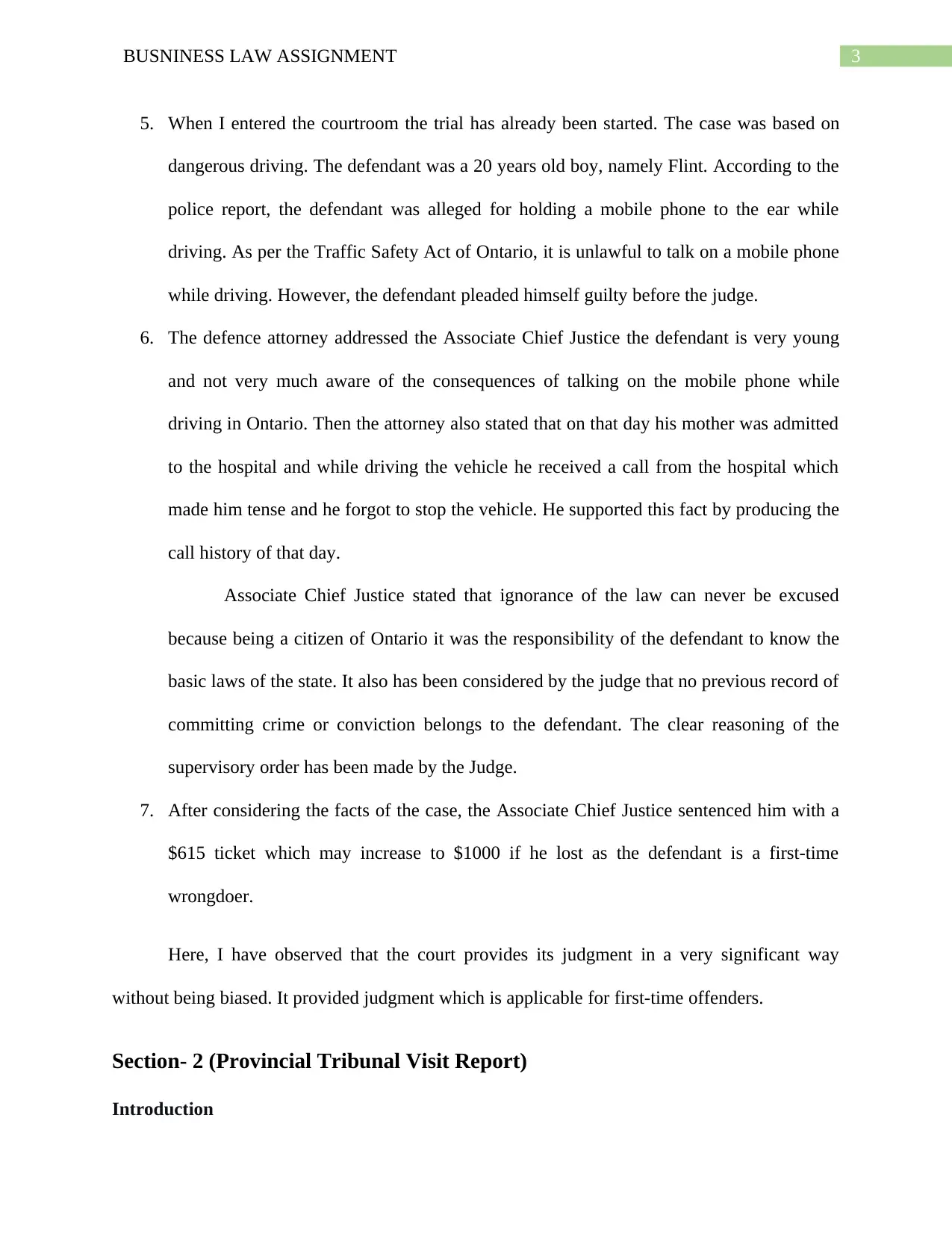
3BUSNINESS LAW ASSIGNMENT
5. When I entered the courtroom the trial has already been started. The case was based on
dangerous driving. The defendant was a 20 years old boy, namely Flint. According to the
police report, the defendant was alleged for holding a mobile phone to the ear while
driving. As per the Traffic Safety Act of Ontario, it is unlawful to talk on a mobile phone
while driving. However, the defendant pleaded himself guilty before the judge.
6. The defence attorney addressed the Associate Chief Justice the defendant is very young
and not very much aware of the consequences of talking on the mobile phone while
driving in Ontario. Then the attorney also stated that on that day his mother was admitted
to the hospital and while driving the vehicle he received a call from the hospital which
made him tense and he forgot to stop the vehicle. He supported this fact by producing the
call history of that day.
Associate Chief Justice stated that ignorance of the law can never be excused
because being a citizen of Ontario it was the responsibility of the defendant to know the
basic laws of the state. It also has been considered by the judge that no previous record of
committing crime or conviction belongs to the defendant. The clear reasoning of the
supervisory order has been made by the Judge.
7. After considering the facts of the case, the Associate Chief Justice sentenced him with a
$615 ticket which may increase to $1000 if he lost as the defendant is a first-time
wrongdoer.
Here, I have observed that the court provides its judgment in a very significant way
without being biased. It provided judgment which is applicable for first-time offenders.
Section- 2 (Provincial Tribunal Visit Report)
Introduction
5. When I entered the courtroom the trial has already been started. The case was based on
dangerous driving. The defendant was a 20 years old boy, namely Flint. According to the
police report, the defendant was alleged for holding a mobile phone to the ear while
driving. As per the Traffic Safety Act of Ontario, it is unlawful to talk on a mobile phone
while driving. However, the defendant pleaded himself guilty before the judge.
6. The defence attorney addressed the Associate Chief Justice the defendant is very young
and not very much aware of the consequences of talking on the mobile phone while
driving in Ontario. Then the attorney also stated that on that day his mother was admitted
to the hospital and while driving the vehicle he received a call from the hospital which
made him tense and he forgot to stop the vehicle. He supported this fact by producing the
call history of that day.
Associate Chief Justice stated that ignorance of the law can never be excused
because being a citizen of Ontario it was the responsibility of the defendant to know the
basic laws of the state. It also has been considered by the judge that no previous record of
committing crime or conviction belongs to the defendant. The clear reasoning of the
supervisory order has been made by the Judge.
7. After considering the facts of the case, the Associate Chief Justice sentenced him with a
$615 ticket which may increase to $1000 if he lost as the defendant is a first-time
wrongdoer.
Here, I have observed that the court provides its judgment in a very significant way
without being biased. It provided judgment which is applicable for first-time offenders.
Section- 2 (Provincial Tribunal Visit Report)
Introduction
Paraphrase This Document
Need a fresh take? Get an instant paraphrase of this document with our AI Paraphraser
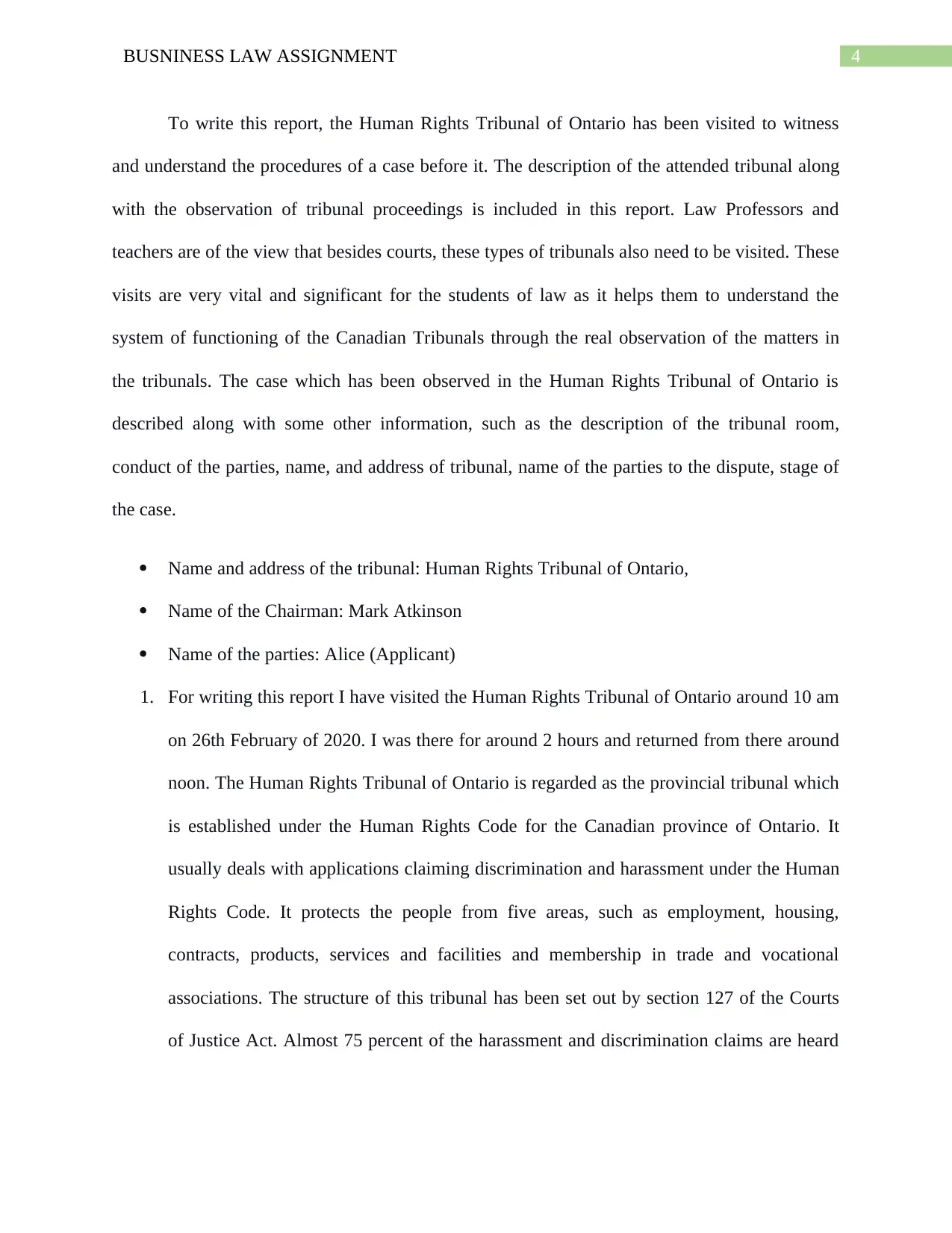
4BUSNINESS LAW ASSIGNMENT
To write this report, the Human Rights Tribunal of Ontario has been visited to witness
and understand the procedures of a case before it. The description of the attended tribunal along
with the observation of tribunal proceedings is included in this report. Law Professors and
teachers are of the view that besides courts, these types of tribunals also need to be visited. These
visits are very vital and significant for the students of law as it helps them to understand the
system of functioning of the Canadian Tribunals through the real observation of the matters in
the tribunals. The case which has been observed in the Human Rights Tribunal of Ontario is
described along with some other information, such as the description of the tribunal room,
conduct of the parties, name, and address of tribunal, name of the parties to the dispute, stage of
the case.
Name and address of the tribunal: Human Rights Tribunal of Ontario,
Name of the Chairman: Mark Atkinson
Name of the parties: Alice (Applicant)
1. For writing this report I have visited the Human Rights Tribunal of Ontario around 10 am
on 26th February of 2020. I was there for around 2 hours and returned from there around
noon. The Human Rights Tribunal of Ontario is regarded as the provincial tribunal which
is established under the Human Rights Code for the Canadian province of Ontario. It
usually deals with applications claiming discrimination and harassment under the Human
Rights Code. It protects the people from five areas, such as employment, housing,
contracts, products, services and facilities and membership in trade and vocational
associations. The structure of this tribunal has been set out by section 127 of the Courts
of Justice Act. Almost 75 percent of the harassment and discrimination claims are heard
To write this report, the Human Rights Tribunal of Ontario has been visited to witness
and understand the procedures of a case before it. The description of the attended tribunal along
with the observation of tribunal proceedings is included in this report. Law Professors and
teachers are of the view that besides courts, these types of tribunals also need to be visited. These
visits are very vital and significant for the students of law as it helps them to understand the
system of functioning of the Canadian Tribunals through the real observation of the matters in
the tribunals. The case which has been observed in the Human Rights Tribunal of Ontario is
described along with some other information, such as the description of the tribunal room,
conduct of the parties, name, and address of tribunal, name of the parties to the dispute, stage of
the case.
Name and address of the tribunal: Human Rights Tribunal of Ontario,
Name of the Chairman: Mark Atkinson
Name of the parties: Alice (Applicant)
1. For writing this report I have visited the Human Rights Tribunal of Ontario around 10 am
on 26th February of 2020. I was there for around 2 hours and returned from there around
noon. The Human Rights Tribunal of Ontario is regarded as the provincial tribunal which
is established under the Human Rights Code for the Canadian province of Ontario. It
usually deals with applications claiming discrimination and harassment under the Human
Rights Code. It protects the people from five areas, such as employment, housing,
contracts, products, services and facilities and membership in trade and vocational
associations. The structure of this tribunal has been set out by section 127 of the Courts
of Justice Act. Almost 75 percent of the harassment and discrimination claims are heard
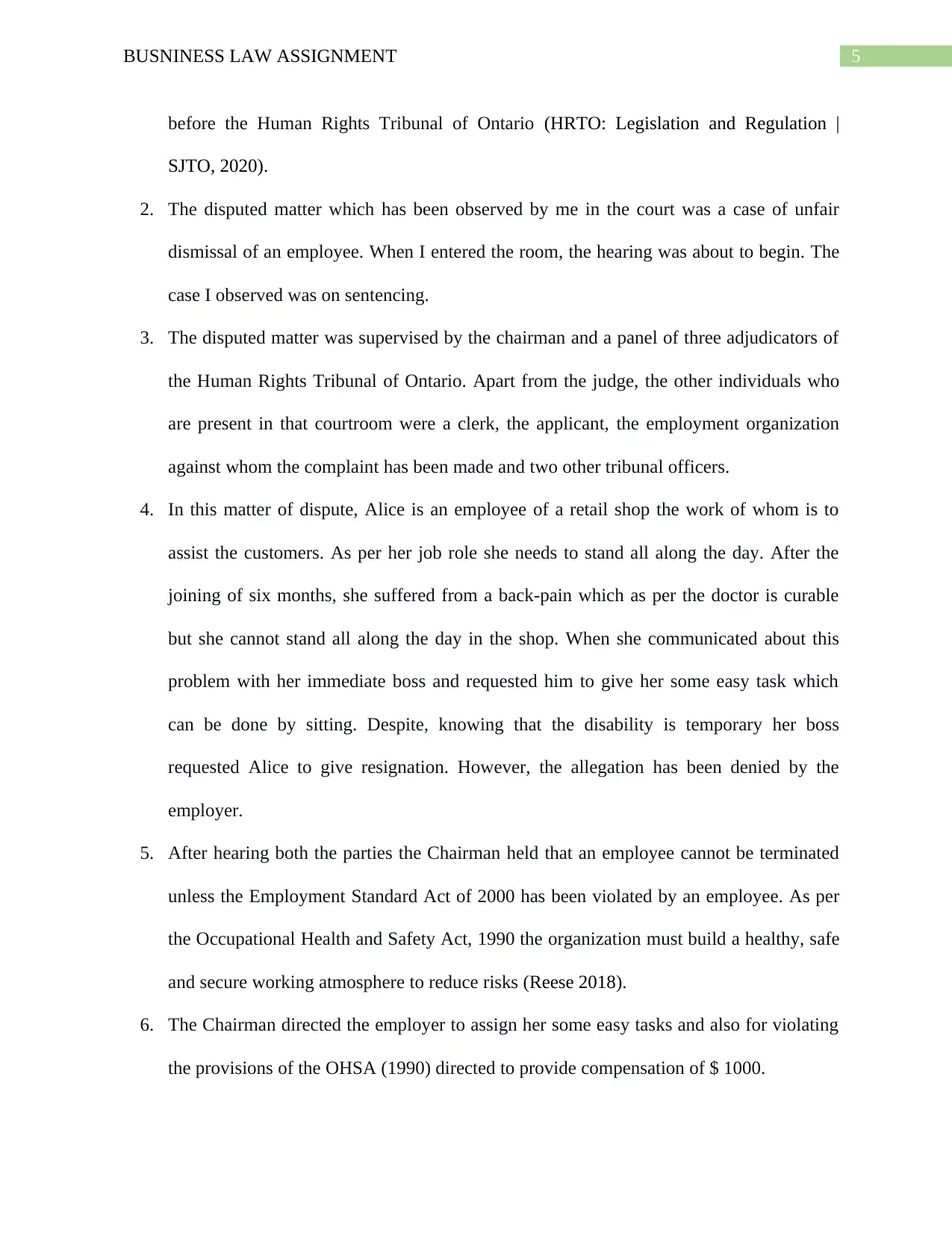
5BUSNINESS LAW ASSIGNMENT
before the Human Rights Tribunal of Ontario (HRTO: Legislation and Regulation |
SJTO, 2020).
2. The disputed matter which has been observed by me in the court was a case of unfair
dismissal of an employee. When I entered the room, the hearing was about to begin. The
case I observed was on sentencing.
3. The disputed matter was supervised by the chairman and a panel of three adjudicators of
the Human Rights Tribunal of Ontario. Apart from the judge, the other individuals who
are present in that courtroom were a clerk, the applicant, the employment organization
against whom the complaint has been made and two other tribunal officers.
4. In this matter of dispute, Alice is an employee of a retail shop the work of whom is to
assist the customers. As per her job role she needs to stand all along the day. After the
joining of six months, she suffered from a back-pain which as per the doctor is curable
but she cannot stand all along the day in the shop. When she communicated about this
problem with her immediate boss and requested him to give her some easy task which
can be done by sitting. Despite, knowing that the disability is temporary her boss
requested Alice to give resignation. However, the allegation has been denied by the
employer.
5. After hearing both the parties the Chairman held that an employee cannot be terminated
unless the Employment Standard Act of 2000 has been violated by an employee. As per
the Occupational Health and Safety Act, 1990 the organization must build a healthy, safe
and secure working atmosphere to reduce risks (Reese 2018).
6. The Chairman directed the employer to assign her some easy tasks and also for violating
the provisions of the OHSA (1990) directed to provide compensation of $ 1000.
before the Human Rights Tribunal of Ontario (HRTO: Legislation and Regulation |
SJTO, 2020).
2. The disputed matter which has been observed by me in the court was a case of unfair
dismissal of an employee. When I entered the room, the hearing was about to begin. The
case I observed was on sentencing.
3. The disputed matter was supervised by the chairman and a panel of three adjudicators of
the Human Rights Tribunal of Ontario. Apart from the judge, the other individuals who
are present in that courtroom were a clerk, the applicant, the employment organization
against whom the complaint has been made and two other tribunal officers.
4. In this matter of dispute, Alice is an employee of a retail shop the work of whom is to
assist the customers. As per her job role she needs to stand all along the day. After the
joining of six months, she suffered from a back-pain which as per the doctor is curable
but she cannot stand all along the day in the shop. When she communicated about this
problem with her immediate boss and requested him to give her some easy task which
can be done by sitting. Despite, knowing that the disability is temporary her boss
requested Alice to give resignation. However, the allegation has been denied by the
employer.
5. After hearing both the parties the Chairman held that an employee cannot be terminated
unless the Employment Standard Act of 2000 has been violated by an employee. As per
the Occupational Health and Safety Act, 1990 the organization must build a healthy, safe
and secure working atmosphere to reduce risks (Reese 2018).
6. The Chairman directed the employer to assign her some easy tasks and also for violating
the provisions of the OHSA (1990) directed to provide compensation of $ 1000.
⊘ This is a preview!⊘
Do you want full access?
Subscribe today to unlock all pages.

Trusted by 1+ million students worldwide
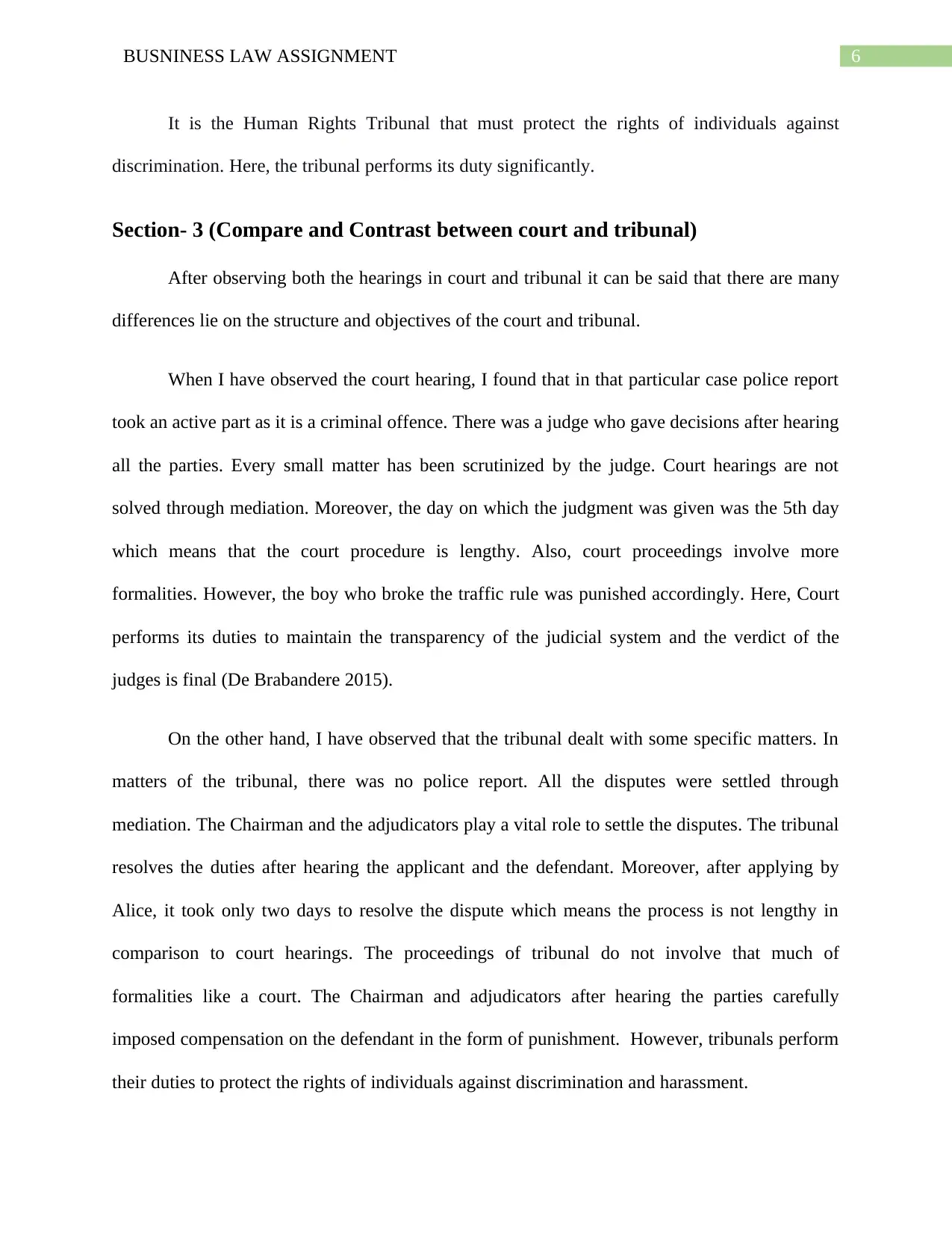
6BUSNINESS LAW ASSIGNMENT
It is the Human Rights Tribunal that must protect the rights of individuals against
discrimination. Here, the tribunal performs its duty significantly.
Section- 3 (Compare and Contrast between court and tribunal)
After observing both the hearings in court and tribunal it can be said that there are many
differences lie on the structure and objectives of the court and tribunal.
When I have observed the court hearing, I found that in that particular case police report
took an active part as it is a criminal offence. There was a judge who gave decisions after hearing
all the parties. Every small matter has been scrutinized by the judge. Court hearings are not
solved through mediation. Moreover, the day on which the judgment was given was the 5th day
which means that the court procedure is lengthy. Also, court proceedings involve more
formalities. However, the boy who broke the traffic rule was punished accordingly. Here, Court
performs its duties to maintain the transparency of the judicial system and the verdict of the
judges is final (De Brabandere 2015).
On the other hand, I have observed that the tribunal dealt with some specific matters. In
matters of the tribunal, there was no police report. All the disputes were settled through
mediation. The Chairman and the adjudicators play a vital role to settle the disputes. The tribunal
resolves the duties after hearing the applicant and the defendant. Moreover, after applying by
Alice, it took only two days to resolve the dispute which means the process is not lengthy in
comparison to court hearings. The proceedings of tribunal do not involve that much of
formalities like a court. The Chairman and adjudicators after hearing the parties carefully
imposed compensation on the defendant in the form of punishment. However, tribunals perform
their duties to protect the rights of individuals against discrimination and harassment.
It is the Human Rights Tribunal that must protect the rights of individuals against
discrimination. Here, the tribunal performs its duty significantly.
Section- 3 (Compare and Contrast between court and tribunal)
After observing both the hearings in court and tribunal it can be said that there are many
differences lie on the structure and objectives of the court and tribunal.
When I have observed the court hearing, I found that in that particular case police report
took an active part as it is a criminal offence. There was a judge who gave decisions after hearing
all the parties. Every small matter has been scrutinized by the judge. Court hearings are not
solved through mediation. Moreover, the day on which the judgment was given was the 5th day
which means that the court procedure is lengthy. Also, court proceedings involve more
formalities. However, the boy who broke the traffic rule was punished accordingly. Here, Court
performs its duties to maintain the transparency of the judicial system and the verdict of the
judges is final (De Brabandere 2015).
On the other hand, I have observed that the tribunal dealt with some specific matters. In
matters of the tribunal, there was no police report. All the disputes were settled through
mediation. The Chairman and the adjudicators play a vital role to settle the disputes. The tribunal
resolves the duties after hearing the applicant and the defendant. Moreover, after applying by
Alice, it took only two days to resolve the dispute which means the process is not lengthy in
comparison to court hearings. The proceedings of tribunal do not involve that much of
formalities like a court. The Chairman and adjudicators after hearing the parties carefully
imposed compensation on the defendant in the form of punishment. However, tribunals perform
their duties to protect the rights of individuals against discrimination and harassment.
Paraphrase This Document
Need a fresh take? Get an instant paraphrase of this document with our AI Paraphraser
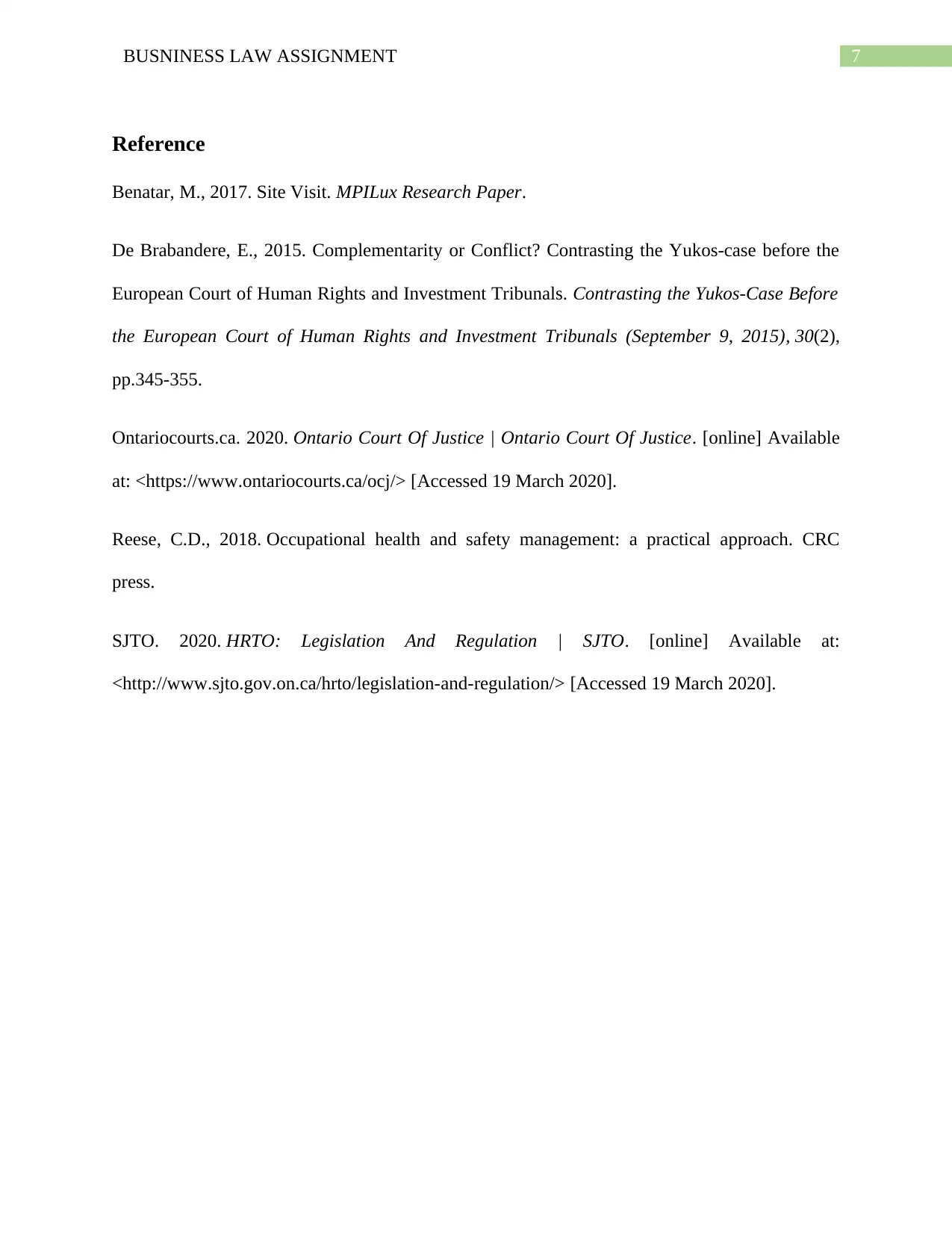
7BUSNINESS LAW ASSIGNMENT
Reference
Benatar, M., 2017. Site Visit. MPILux Research Paper.
De Brabandere, E., 2015. Complementarity or Conflict? Contrasting the Yukos-case before the
European Court of Human Rights and Investment Tribunals. Contrasting the Yukos-Case Before
the European Court of Human Rights and Investment Tribunals (September 9, 2015), 30(2),
pp.345-355.
Ontariocourts.ca. 2020. Ontario Court Of Justice | Ontario Court Of Justice. [online] Available
at: <https://www.ontariocourts.ca/ocj/> [Accessed 19 March 2020].
Reese, C.D., 2018. Occupational health and safety management: a practical approach. CRC
press.
SJTO. 2020. HRTO: Legislation And Regulation | SJTO. [online] Available at:
<http://www.sjto.gov.on.ca/hrto/legislation-and-regulation/> [Accessed 19 March 2020].
Reference
Benatar, M., 2017. Site Visit. MPILux Research Paper.
De Brabandere, E., 2015. Complementarity or Conflict? Contrasting the Yukos-case before the
European Court of Human Rights and Investment Tribunals. Contrasting the Yukos-Case Before
the European Court of Human Rights and Investment Tribunals (September 9, 2015), 30(2),
pp.345-355.
Ontariocourts.ca. 2020. Ontario Court Of Justice | Ontario Court Of Justice. [online] Available
at: <https://www.ontariocourts.ca/ocj/> [Accessed 19 March 2020].
Reese, C.D., 2018. Occupational health and safety management: a practical approach. CRC
press.
SJTO. 2020. HRTO: Legislation And Regulation | SJTO. [online] Available at:
<http://www.sjto.gov.on.ca/hrto/legislation-and-regulation/> [Accessed 19 March 2020].
1 out of 8
Related Documents
Your All-in-One AI-Powered Toolkit for Academic Success.
+13062052269
info@desklib.com
Available 24*7 on WhatsApp / Email
![[object Object]](/_next/static/media/star-bottom.7253800d.svg)
Unlock your academic potential
Copyright © 2020–2025 A2Z Services. All Rights Reserved. Developed and managed by ZUCOL.





